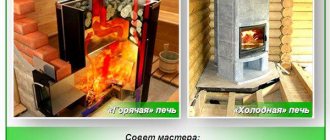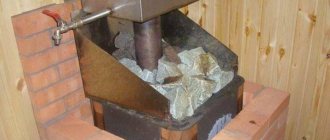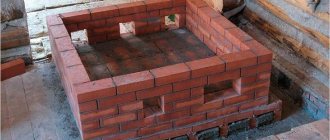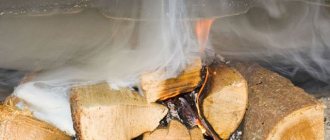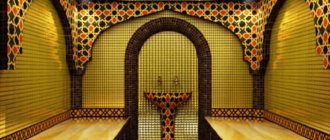A deck oven in a nutshell
Lately, more and more often, customers are asking us to make them
a deck oven .
I must say that this is a fad of literally recent years - somehow there was no talk about this before. And so: I want a hearth! Let's look into the details. First of all, let's define what a deck oven is. A hearth is a stove in which the firebox is devoid of an ash pan and a grate. In other words, in a deck oven, fuel burns in the same way as wood burns in a fire, or in a hearth. The fuel simply burns at the bottom of the combustion chamber, or just the firebox. The most striking example is the Russian stove. There is the bottom of a spacious firebox, or under, and logs are stacked on it. Or, here, the fireplace is the most, I think, familiar example to everyone. A fireplace is essentially a fire surrounded by stones. The wood burns like in a fire, the smoke along with the flue gases goes vertically into a chimney located above the fire - the simplest version of the combustion process. In other words, there may be indescribable beauty outside, but inside it is Paleolithic: the hearth of a caveman. And no science. This is essentially a fireplace, beloved by so many. This is in warm climates where there is enough radiant energy to provide warmth.
In Rus', things were different - the climate was different.
It’s difficult to say when exactly he became different, but it’s obvious that at the beginning it was also warm. And then it got colder. This is evidenced by the design of the Russian stove. When radiant heat became insufficient, a savvy Russian peasant decided to move the fire deeper: he moved the back wall of the fireplace, creating an additional combustion chamber. And before the smoke exited, he attached a cover - an obstacle to force the smoke to fall down, and leave some of the heat at the top, in the cap thus formed. of the deck oven appeared .
But gradually people figured out how to optimize this process as well. I came up with the idea of enhancing the natural combustion process by supplying additional air and removing non-combustible debris formed during the combustion process, which interferes with the full combustion of the fuel. In other words, he came up with an ash pit, a blower door and a grate , or grate .
It is believed that this happened with the advent of the steam engine and coal-fired locomotive, which needed a higher combustion temperature. However, I think that much earlier, since blacksmithing has existed since time immemorial, and in the forge hearth they use forced air injection, and the grate, together with the bellows, serves precisely to supply additional air to the fuel combustion area. But this is already a historical question. We understand the features of the firebox design.
So, the additional air supply was quite a serious step forward. Now the fuel could be burned under more optimal conditions. Moreover, through the grate not only air is supplied to the fuel from below, but also helps to remove the products of incomplete combustion down into the ash chamber, thereby increasing the supply of oxygen to the fuel. And this increases the intensity of combustion. As a result, it becomes possible to increase the combustion temperature, which means that the efficiency of fuel combustion increases: more energy is released and less soot is formed. And this is good: less fuel is needed for heating and more heat is generated!
The second consequence : the fuel combustion time is also shorter and, therefore, during the same time, more heat is released in the firebox than in a furnace that does not have an ash pit, that is, in a hearth . Why is it important? But because you can close the pipe earlier and leave more heat in the stove, and therefore in the room. Because while the pipe is open, heat literally flies out into it, and we drown the atmosphere. How to optimize the process?
Obviously, it is necessary to reduce the heating time of the furnace, but at the same time increase the combustion temperature. Then more heat will be released per unit time. This is exactly what the ash chamber and grate serve. The sooner we close the stove, the more heat will remain in the stove after closing the chimney. Therefore, the ash pan and grate are a useful invention. This, one might say, is a new stage in the development of stoves.
Advantages and disadvantages of homemade sauna stoves
Most often, a metal or brick stove is chosen for a bathhouse, and in order to make the right choice, their advantages and disadvantages are taken into account.
Among the “advantages” of metal sauna stoves, it is worth highlighting the following:
- quick heating of the steam room (stone or brick gives off less heat than metal: a couple of hours after the start of kindling, and sometimes even earlier, you can go steam);
- compact design (this allows you to get more space in the main bath room);
- durability (subject to high-quality assembly, the stove will last from five to fifteen years);
- ease of use (compact metal stoves can be transported from one place to another);
- ease of manufacture (unlike, for example, the brick version);
- profitability (materials for the production of baths are inexpensive).
The advantages of a brick kiln include:
- soft steam, which is typical for spacious brick ovens;
- long-term preservation of steam and heat;
Soft steam from a brick stove Source wikimedia.org
- ease of use (there is no need to take fire protection measures before operating such a stove);
- aesthetic appeal (a brick stove looks very presentable, unlike its metal counterparts);
- ease of construction.
A simple stove for a sauna Source neoenerg.ru
However, for both types of homemade sauna stoves, the following negative points must be taken into account:
| Metal | Brick |
| Rapid cooling, which forces you to regularly add solid fuel | Heavy weight |
| The stove walls heat up too much, which reduces fire safety | Lack of mobility (all brick stoves are stationary) |
| In most cases, only suitable for small bath spaces | It is necessary to build a foundation for the furnace |
| Limited number of forms and modifications | The need to allocate a fairly large space in the bathhouse for installing a brick stove |
| Possibility of deformation from strong heat | Need to spend more money on buying building materials |
| Too dry air | Even one mistake in the brickwork can make the stove of poor quality (it will not hold high temperatures well) |
| Emission of infrared radiation | Low preparation speed for steaming (all preparatory work can be completed within an hour, and then it will take up to five to six hours for kindling). |
| Uneven distribution of heated air | — |
| The chimney needs to be cleaned constantly | — |
The chimney of a metal stove needs to be constantly cleaned Source kamin.lutsk.ua
conclusions
So, let's summarize.
- Bottom combustion is a slower and less intense process; as a result, the wood burns longer and the stove takes longer to heat the outside, rather than the room. Firewood consumption is higher
. - Combustion in a firebox with an ash pan and a grate is optimal for heating needs: the combustion process proceeds more efficiently, at a higher temperature, with greater heat release. And, as a result, it requires less fuel
. - The design of a modern furnace with an ash pan and a grate makes it possible, if desired, to organize both a faster combustion process using a grate and blowing air through the ash chamber, and a slower one, like bottom combustion. While a deck oven lacks the ability to optimize the combustion process. The grate stove is universal.
Features, types of metal and brick stoves
Simple in shape, metal sauna stoves may differ slightly in design. The classic, easiest to make option is the potbelly stove. Essentially it is a metal box with a door and a pipe. However, this form is considered uneconomical: fuel consumption is high and heat transfer is low. The thickness of the metal for a modern, more economical type of sauna stove should not be too large, the optimal one is 4-5 mm.
Some owners make a combined stove for their bathhouse, the core of which consists of metal sheets, and the outside of the structure is lined with bricks. Thus, they achieve a reduction in fire hazard and an improvement in the uniformity of heating of the surrounding air. The basis for installing such a furnace can be a concrete slab lined with ceramic tiles, refractory bricks or a metal sheet.
Among the small variety of types of metal sauna stoves, three main types stand out: closed, open and combined stoves. The first type is distinguished by a completely closed combustion zone and small size. Open stoves contain in their design places for laying out heating stones that do not close.
Closed oven Source tildacdn.com
Typically, the firebox of a homemade iron stove for a bath is placed in the waiting room, and the part with heating stones is located directly in the steam room. To properly operate an open stove, it is necessary to ensure maximum contact of stones with the outer surface of the firebox.
As for combination stoves, they have the additional ability to heat the air in the room. This can be done by equipping the structure with a network of pipes, which are attached to the stove through a pipe and are then brought out so that they cover the entire perimeter of the bathhouse complex. When the fuel in the stove burns, the energy generated heats the air, after which it begins to circulate through the pipe system. In this case, the supply of heated air is carried out by moving a special grille in the form of a valve.
Brick stoves themselves are safer than metal stoves, and also more convenient. The reason lies in the gradual and uniform heating of the air surrounding the stove. The location for the construction of such a stove must be chosen carefully. The heating element should be located near the wall of the room, but no closer than twenty centimeters from it.
Brick oven Source wmpics.pics
See also: Catalog of companies that specialize in the design and installation of fireplaces and stoves
The opinion of the luminaries
A.I. Shkolnik , a generally recognized authority among modern stove makers, says about this
“ The efficiency of a firebox with a solid bottom , that is, without a blower and grate, does not exceed 35% . The low efficiency of a firebox with a solid bottom is explained by the following reasons. Firstly, excess air, which, without participating in the combustion reaction, passes through the furnace in transit and cools its surfaces. Secondly, the low temperature of the supply air, which does not come into contact with the heat-transfer medium. Thirdly, the air in a firebox with a solid bottom moves above the fuel and not through its thickness.
A firebox with a blind bottom is more difficult to operate than a firebox equipped with a grate, since access to a sufficient amount of air is difficult for the fuel located deep in the fuel volume and the fuel does not burn. In order for the fuel to burn, it must be moved to the front of the firebox. In addition, it is necessary to continuously monitor the fuel combustion process, loosen and move it within the hearth. When loosening the burning layer, doors 2 and 3 have to be opened, which leads to additional cooling of the furnace mass with air.” (A.E. Shkolnik. Stove heating of low-rise buildings. M., 1991, p. 24)
And here are the words of I. S. Podgorodnikov , creator of the first two-bell furnaces, which are now called Kuznetsov furnaces:
“When burning fuel on a blind hearth (i.e. without a grate - my clarification - O.S.), most of the air necessary for combustion passes over the fuel, carrying the heat with it into the chimney ." (I. S. Podgorodnikov. Household two-bell stoves., M., 1992, p. 22)
How metal sauna stoves are made
To make a homemade metal sauna stove, you will need:
- five- to eight-millimeter steel sheet (several pieces will be needed, and the size and quantity will depend on the dimensions of the firebox of the stove being manufactured);
- water tap;
- ruler or tape measure;
- Bulgarian;
- a thin metal pipe with a thickness of 5 mm to 10 mm and a length of about two meters;
- grate;
- metal scissors;
- hinges and latches (depend on the number and shape of stove doors);
- four metal squares with a side length of 10 mm, or doors for three functional compartments of the stove: for the firebox, heater and blower;
- welding machine.
First of all, the firebox is made. To do this, nine square pieces of metal measuring 50 × 50 cm are measured on a metal sheet and a box is welded from them. There should be another one inside (a separating plate), while the upper part of the firebox is needed to burn fuel, and the lower part is needed to collect ash and ash. In each of these parts, holes for the doors are cut so that they are located on top of each other. After attaching the doors, proceed to the next stage.
One of the options for a stove for a bath (drawing) Source vbanepar.ru
Next, two pieces are cut from a two-meter pipe: one for the firebox (90 cm), the second for the tank (60 cm), and the first of them is welded to the firebox. After this, make a rectangular hole in a larger section of the pipe with dimensions of 20 × 50 cm for the blower and securely attach the door to it. A grate (grid) is welded onto the resulting product.
Remember! To heat a room of 14 m², it is enough to have a heater with dimensions of 30 × 40 × 30 cm.
To make a heater (that part of the stove that will contain heated stones), they take several more pieces of the plate and make a container out of them, then thick iron rods (thickness - at least ten millimeters) are welded on top of the prepared firebox. Be sure to make a hole for the door and carefully weld it onto the hinges. It is worth paying attention to the fact that the structure must be strong, because these rods or metal plates need to hold a fairly large weight of stones.
Important! To fill the heater, they usually take diabase or soapstone, but refuse to use granite (it crumbles after strong heating) and stones containing mica (it helps release carbon dioxide) or the inclusion of silicon.
A heater on a stove, welded from rods Source hozsektor.ru
Another important structural element of a homemade stove is a water tank. Above the manufactured heater, first of all, another metal plate (thickness - at least 8 mm) with a pre-made hole for the chimney is welded. After this, the pipe prepared for the smoke exit is also carefully welded to the edges of the round hole.
At the final stage, they do one more thing - in the area of the rear wall of the structure, and attach a water tap. A pipe for the tank is then welded to it. It is important to make the water tank small so that you can easily weld it on top of the stove, above the heater or next to it.
In the resulting product, after welding all the structural parts together, each node will perform its functions. So, at the very bottom (above the ash container), that is, in the firebox, fuel (for example, harvested firewood) is burned, then the heat moves through the stove to the stone section, strongly heating the stones. In this case, these stone blocks can be changed or added through the door in the heater (if it is a closed type), and the smoke comes out through the chimney.
One of the options for placing a water tank and heater on a sauna stove Source baniwood.ru
The water tank is equipped with an additional lid or other auxiliary parts that will allow you to periodically fill the container with new cold liquid. Thus, they create the simplest homemade iron sauna stove with a water tank and a heater.
Metal for sauna stove
As for the metal from which a homemade stove is made, cast iron material is usually chosen, because it is much more difficult to fasten (if there are no difficulties with fastenings, cast iron is well suited for the firebox door).
Iron plates are used, but they must take into account that when such a stove operates, the temperature in the combustion chamber rises to four hundred and fifty degrees Celsius. Thin metal under such loads begins to deform and burn through. When choosing a stainless metal with a sheet thickness of 10 mm or more, you can avoid this problem, but another one will appear - the warm-up time will increase significantly, and with it, fuel consumption.
Structural steel for furnace Source steelsukraine.com.ua
If a non-professional nevertheless decides to make a stove with his own hands, be sure to take into account the advice of experts who recommend using stainless high-alloy steel grade 08x17T. It is practically not subject to corrosion and destruction by high temperatures. An example of a product that is made of just such steel is AISI 430. It will not change its shape even when heated to a temperature of + 850 °C.
The furnace compartment, called the firebox, is exposed to the highest temperature and is in direct contact with the flame. That is why steel grade 10 is chosen for this structural part (manufactured according to the GOST 1050-88 standard); for convection parts, 08PS or 08YU is suitable (manufactured according to the rules of GOST 19904-90). Structural sheet steel is considered ideal for the body of a sauna stove.
How to choose?
First you need to figure out the power of the steam room stove.
As an example, we take the dimensions of the bath:
- width – 2 m;
- height – 2.2 m;
- length 3 m.
In this case, the total area is calculated by multiplying the length and width of the room. In our case, it is equal to 6m2. But volume is important to us to calculate power. Therefore, you will need to multiply the area by the height of the walls - 6 * 2.2 = 13.2 m3.
Now it is important to calculate possible heat loss . To do this, having determined the total area of windows and doors, we multiply this value by 1.2. Our steam room has one stove and a window in the dressing room. Therefore, we take heat loss equal to 2.3 m3. We add up the total volume and the volume of losses - 15.3 m3.
Next, you need to determine the power taking into account the level of heat absorption. For calculation purposes, we assume that our bathhouse is made of wooden logs. In this case, we multiply the resulting volume and the coefficient; for log walls it is equal to 1.6. 15.3*1.6=24.48. We round up and find that for our steam room made of logs with one door and window, you will need to purchase a stove with a capacity of 25 kW .
This is an approximate and rough calculation. When choosing a stove for a sauna, you need to pay attention to several more factors.
In addition to power, when choosing a mini-oven, it is important to pay attention to several more factors;
- Type of fuel burned. Domestic and foreign manufacturers produce stoves for small baths that run on different types of fuel. The most expensive ones to operate are electric heaters. Even stoves that run on diesel fuel or coal have been developed. But for Russian lovers of steam and brooms, wood-burning stoves remain the most popular.
- You should pay attention to the design of the combustion chamber. You can purchase a design with the ability to move the firebox to a separate room. For mini baths, this is the best option, but it will require large expenses when purchasing. But this option has one undeniable advantage - you don’t need to litter and stack firewood in the steam room.
- Find out the type of backfill and the device of the heater. They can be closed or open. Of course, open heaters are most in demand among conservatives, but it is closed compartments with stones that are gaining popularity.
When choosing small stoves for a bath, pay attention to several models presented in our TOP on pechnoy.guru.
How to make a brick stove for a bath
A bath stove can also be made from bricks. Unlike the installation of a metal sauna stove, the brick version requires the construction of a foundation, since the device will be stationary.
Refractory brick for the stove Source prom.st
The fuel combustion chamber is lined with refractory bricks, while the external (visible) parts are decorated with burnt red. Masonry mortar is made from a mixture of sand and clay. It is the clay component that will firmly hold the brickwork. The most common version of a homemade sauna stove is a design with a base of 890 by 1020 mm. To do this, standard brick blocks are laid in a base 3.5 by 4 bricks wide. When choosing a stove with base dimensions of 1020 × 1290 mm, blocks are laid in a stove foundation measuring 4 by 5 bricks. The dimensions of a conventional stove, including the chimney, are usually 168-210 cm.
Important! Cement is not used in the manufacture of sauna stoves, as it crumbles when the masonry is heated.
Cylindrical boilers
The easiest way is to make a boiler for a bath from a pipe with thick walls (6-8 mm). You can take a thin-walled pipe, or even an iron barrel, but such a stove will not last long. So, a pipe with a diameter of 400-500 mm up to 1 m in length will be the combustion chamber. The bottom and cover made of a steel sheet with a thickness of at least 5 mm should be welded to it. Such a boiler for a bath can be made without a grate; all operations are performed through the loading door. The external channel for its installation can be made of rectangular or circular cross-section, its length is equal to the thickness of the bathhouse wall.
Boiler in a bathhouse from a pipe
There is a hole in the center of the lid to which the chimney pipe is welded. You can regulate the intensity of combustion by installing a damper in the chimney, which will reduce draft. But more often they make a hole in the door and cut a pipe with a damper into it, as shown in the figure.
Side on the boiler
A homemade boiler for a bathhouse made from a pipe must have a heater, here a special side made of steel 4 mm thick is welded for it. This is the simplest stove model, and the pipe can be positioned horizontally, especially if it has a large diameter. Then the door will need to be installed at the end, and the chimney will need to be welded at the end of the pipe. For stability, you will need to attach supports to the firebox body.
Homemade boiler for a bath
Video description
To see how a 3x3.5 brick stove is laid, see this video:
When choosing a brick for a sauna stove, be sure to pay attention to the absence of cracks and chips, as well as mica film. The standard version is suitable, having the following dimensions: 25 × 250 × 65 mm (permissible deviation - 2 mm). If thin thread-like cracks and very slight grooves are observed on the brick, such a building material is considered to be of high quality and suitable for construction. To make the stove level, the bricks must be the same size.
Before starting the manufacture of a homemade stove, after preparing the bricks, sand mixture and a grinder with a diamond disc for cutting building materials, pre-lay (without mortar) the bottom (zero) layer. After the issue with the size and layout of the furnace base has been resolved, the first layer of bricks is put back, since first of all it is necessary to make waterproofing, securing it to the foundation.
After this, the sand and clay are cleaned of stones and other foreign matter. The clay is soaked for several days. The best material for such work is a clay mass mined in the area of one and a half meters from the surface of the earth.
Mortar of clay and sand Source 2proraba.com
Important! Always choose the clay that is part of the brick that will be strengthened with its help (for example, for fireclay bricks, it would be ideal to use fireclay clay for mortar).
Unlike making an iron stove for a bathhouse, a brick stove requires a bonding agent. To get a good solution, combine clay with water and sand, after which everything is thoroughly mixed. If the clay has a high fat content, it can be diluted in a ratio of 1 to 2, that is, one part clay to two parts sand.
You can check whether the solution came out correctly as follows. Take a wooden stick and dip it into the solution. After this, they carefully look at the sand-clay layer that has stuck to the piece of wood: if its thickness is 2 mm, they begin the intended work.
Prepare for installation:
- bricks;
- emery wheel;
- order;
- pliers;
- broom and dustpan;
- container for soaking bricks and water.
In order to remove unnecessary air bubbles from the brick, as well as to prevent dehydration of the solution and wash away dust, it is pre-soaked, that is, immersed in water for a while immediately before laying begins.
This is how bricks are soaked Source kronotech.ru
Horizontal boiler for a bath
The original horizontal boiler is quite common. Its production differs from the classical scheme:
- Holes must be cut in the pipe according to the diagram.
- It is necessary to create a heater in the upper part, it is very convenient.
- Such a stove is located on legs.
The chimney is connected to one side. Additionally, be sure to check the traction force.
Features and important nuances of constructing a stove for a bath
In order to properly make a homemade stove for a wood-burning sauna with a water tank or build a brick one, you need to know in advance some rules that should be followed when working on this useful device:
- They think in advance about exactly what plan the stove will be made in order to prepare all the necessary tools and materials in sufficient quantity.
- To produce a metal furnace, you can also use an unnecessary iron barrel, which eliminates the common problem of unsoldering the seams of the product.
- After completing the welding work (if any), be sure to check each seam made for integrity.
- A container for laying stones can be provided for both metal and brick sauna stoves.
- When selecting bricks, clay, sand or metal sheets for making a bathhouse, you should always give preference to high-quality materials. In some cases, the material is improved independently: for example, sand is sifted to include large fractions, and other components are cleared of debris.
What materials to make the boiler from?
During operation, the structural elements of the boiler are exposed to high temperatures, so thick metal must be used to assemble it to prevent burnout.
If a suitable pipe or container could not be found, then such a device can be made according to the drawing from sheet iron.
Metal sheets
For the walls of the unit, sheet steel grade St3 with a thickness of 5 mm is suitable, the bottom should be even thicker - at least 10 mm.
Video description
One of the options for assembling a bathhouse using the example of a layout is shown in this video:
- When making a stove, they always remember that the stove is being made for loved ones, relatives, and friends, so they always check the safety of using the selected building materials.
- The quality of steaming in a built sauna depends, among other things, on the regularity and thoroughness of cleaning the stove.
- If an already unnecessary gas cylinder is used for a sauna stove, the doors are carefully cut out from it, then additional money is avoided on these structural elements.
- Homemade sauna stoves can have a vertical or horizontal firebox.
- When purchasing doors for the firebox and ash pans, compare their size in advance with the dimensions of the future stove (they also think about it in advance and purchase fasteners in the required quantity).
- If the stove is made without a heating water tank, you just need to equip the chimney with a steel heat exchanger and run pipes to the water used for showering, then the thermal energy generated in the firebox is used more fully.
Drawings of a metal stove for a bath Source oboiman.ru
- The air flow, when passing through a stove made of a thick pipe, a metal barrel or an unused cylinder, flows around it, thus improving heat transfer.
- A very hot metal stove is additionally separated from the rest of the space by brick walls, then the level of fire safety is acceptable.
Designs with built-in or mounted water tank
A water heating tank is a metal container of a certain volume into which cold water is initially poured and during the heating process of the furnace it is heated.
A hanging tank, which is located on the other side of the stove (in some cases even in another room) is not always convenient. Also dubious is the pleasure of washing from the tank, which is built into the stove body.
Firstly, it is impossible to control how much water is left and whether it needs to be added. Secondly, constantly boiling water produces too much steam, which is not very comfortable for a small steam room.
Advantages of a remote water tank
Any storage container in a bathhouse can be heated in one of two ways - either from the firebox itself or from the chimney pipe. The remote tank can only heat up through the pipes leading from the furnace coil. The disadvantage of the design is the need to be close to the stove (no more than 300 cm), but for most steam rooms this is enough.
Example of a remote water tank
In general, heating water in a bathhouse can be organized systematically - if the tank is large, the best location would be a chimney, when the passing hot smoke heats the water. Small storage tanks can be installed directly on the heater, but then it is necessary to organize a good steam outlet. It is advisable to install small tanks outside the steam room.
Briefly about the main thing
Brick and iron stoves for baths bring even more benefits if they are carried out after appropriate calculations and drawing up a diagram.
Bath stoves can have different volumes, which depend on the size of the steam room and the type of bath.
Metal stoves are good for their mobility, simplicity and ease of manufacture, while brick stoves are good for their aesthetic appeal, softness of steam and safety.
Each of the sauna stove options has its own negative aspects: brick products are heavy, emit infrared radiation and require additional fire safety measures, while brick products require cleaning and heat up unevenly.
A metal sauna stove is made from thick sheets, but for brick stoves you need to purchase a certain amount of refractory bricks.
A device for heating water and steam for bathing procedures can be combined and include several different materials in its design.
Typically, a sauna stove design includes a firebox, a heater, a place for ash and a heating tank with water.
Thin metal used for a sauna stove may burn out after several uses, and non-combustible brick in the firebox may burst or crack.
Doors are one of the most important elements of a sauna stove, therefore they must be selected with special attention or made independently.
Since there are a lot of designs for sauna stoves, each master designs his own unique version for his home or cottage.
To choose a suitable stove for a bath, consider the manufacturing features of each of them.
Ratings 0
Recommendations for choosing a boiler for a bath
There are several basic criteria to consider in order to choose the right boiler. These include the following factors:
- Ability to maintain temperature stably;
- The area of the room to be heated;
- Easy installation and the ability to install it yourself;
- Safety, in particular the type of fuel must be taken into account.
It is imperative to focus on these basic features so that construction and installation, as well as operation, do not cause additional problems.
Distinctive parameters of the Russian bath
Externally, a modern Russian bathhouse may look different, but there is something that has remained an unchanged tradition - the special microclimate of the bathhouse:
- air temperature within 60-65 degrees. Celsius. Definitely no more than 70oC!
- humidity within 50-60%.
- finely dispersed steam - this is the kind of steam that is formed under the ceiling of the bathhouse (it is also called “steam cake”).
Of course, if the stove provides the characteristics of creating such a microclimate, then such a stove is suitable for a Russian bath.
If we translate these parameters into ordinary sensations, then in Rus' it was called “light steam”. We think you've heard this expression...
“Light steam” is obtained in a bath with the following indicators: air temperature 60-70oC, humidity - 50-60%. Everything that goes beyond these limits is called a “sauna” or “hamam”.
So, there is an opinion that no other material other than stone heated by fire can create the conditions for the formation of the so-called “light steam” for which Russian baths are famous. It is the light steam that gives rise to sayings in the style: “The day you steam, the day you don’t grow old...”. In our folklore, accurate and apt observations related to the bathhouse have survived through the centuries, and from them you can immediately find out which bathhouse we are talking about.
Compare the parameters of “light steam” with other options for baths and saunas:
Figure 2. Temperature and humidity parameters for different types of baths and saunas
Types of heat exchangers for boilers
To heat water, as well as heat the room, if it is large enough and the stove cannot cope, it is necessary to consider a heat exchanger. They differ primarily in material. The best option is copper. However, such metal is not affordable for everyone. It is possible to replace it with carbon steel and get a similar result. However, it is best to purchase a ready-made option. After all, it is quite difficult to correctly assemble a heat exchanger with your own hands.
Tubular heat exchanger
In most cases, the heat exchanger is a kind of coil; it can also be spiral or composed of two pipes, when one is located in the other. It must be taken into account that one end of it must be connected to the heating system, and the other must be located directly in the boiler.
Where to install heat exchangers
The heat exchanger installation process provides several options for choosing a location:
- Inside the firebox;
- Near the body;
- In close proximity to the chimney.
Depending on the design of the boiler, as well as on the room itself, you definitely need to focus on the option that will be most convenient.
